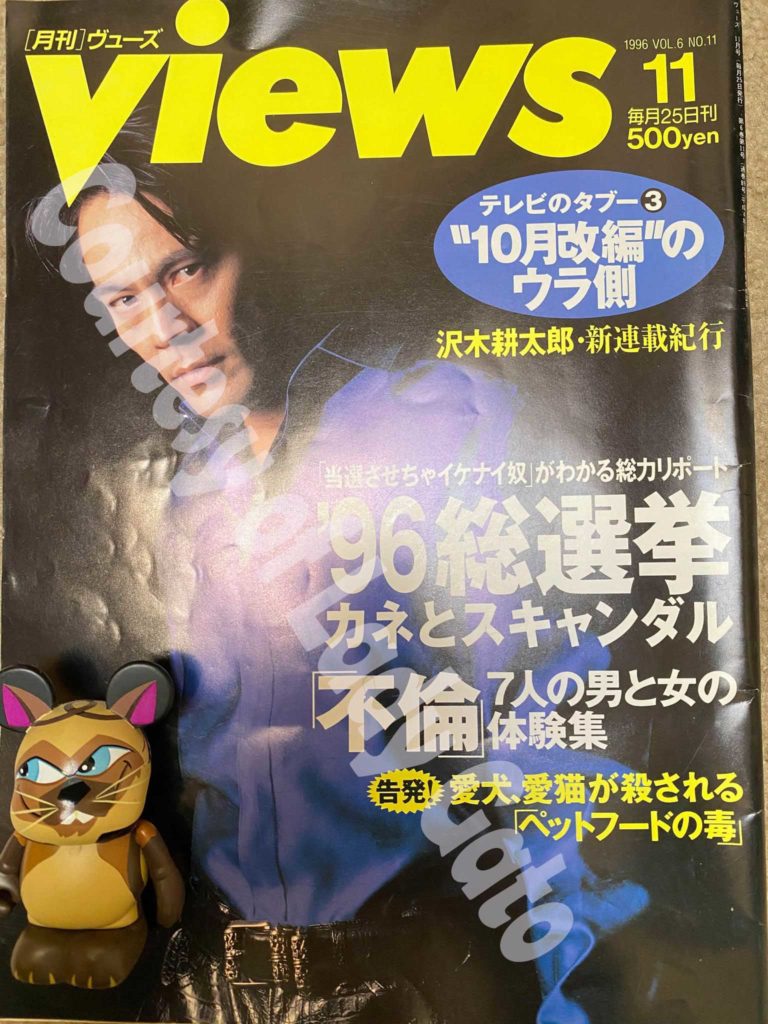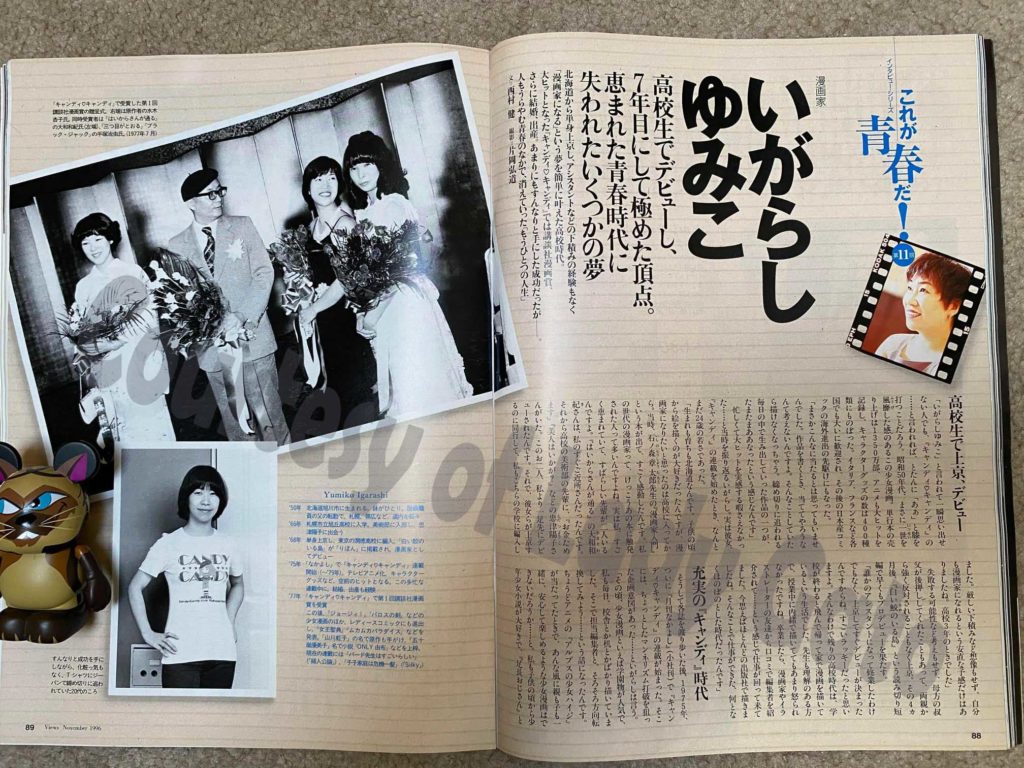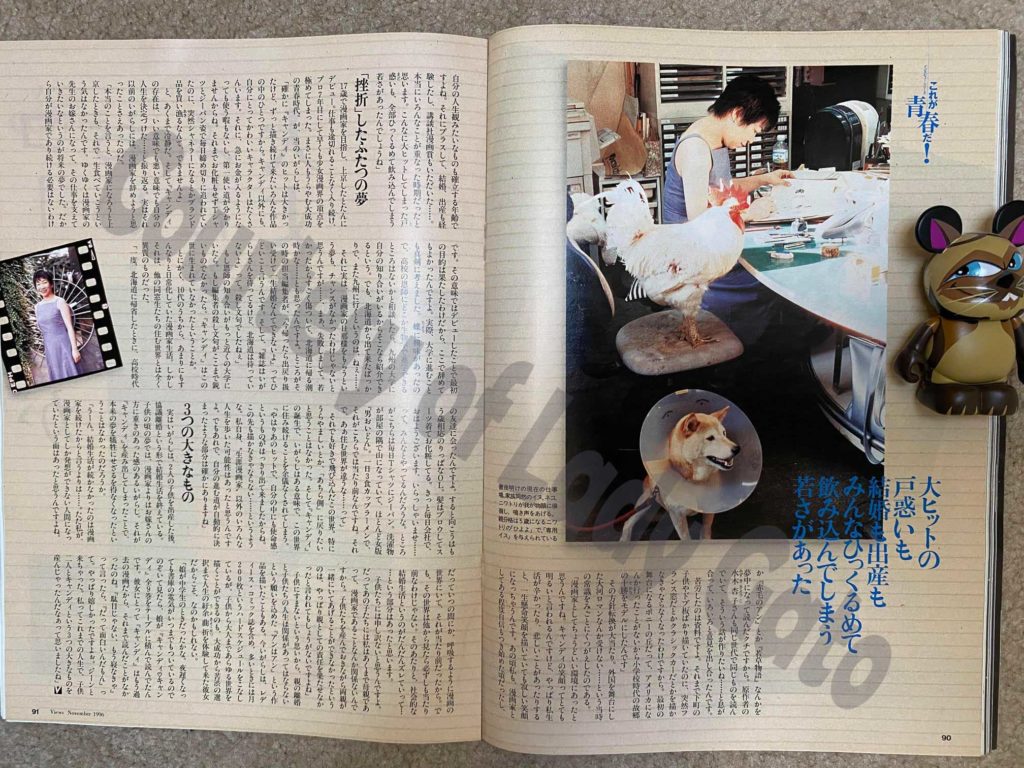This is Youth
(Translation of article on Yumiko Igarashi in the Japanese magazine Views, published in March 1996.)
Written by Ken Nishimura
Photographs by Hiromichi Kataoka

Thank you to Candy Candy Superfan Lady Gato for sharing this article.
Interview Series
This is youth! #11
Manga Artist
Yumiko Igarashi
Debuted while a high school student, and reached the top in her seventh year. A privileged youth and dreams that were lost. All alone, she moved from Hokkaido to Tokyo. And without any experience as an assistant, she easily made her dream of ‘becoming a manga artist’ come true, while still a high school student. ‘Candy Candy’ was a great hit and won her the Kodansha Manga award. This was followed by marriage and children. Her success seems to have been acquired so effortlessly, but . . . There was ‘another life’ that had disappeared during her enviable youth.
The move to Tokyo as a high school student, and the debut
While some may not immediately recollect when hearing the name ‘Yumiko Igarashi,’ when hearing ‘Candy Candy’ . . . they are likely to slap their knee with an ‘Ah!’ After all, it was one of those shoujo mangas that dominated the 70s. Sales of the manga volumes reached 13.5 million, while the anime was a great hit. And there were over 400 kinds of character merchandise. It was also well received abroad, in countries such as Italy and France, making it one of the pioneers of Japanese comics going overseas.
‘I never thought that it would become this big. When writing something, I am never thinking about trying to make a hit. If I did, I would not be able to draw. It is just that one of the things I worked on while being stressed over the deadline just happened to catch on. That’s what it feels like.’
She was so busy that she didn’t have time to take in the success… Says Igarashi as she looks back on that time. In fact, when ‘Candy’s’ serialization began, she was only 24 years old. ‘I was born and raised in Hokkaido. And while I loved to draw ever since I was a child, it wasn’t until I entered high school that I wanted to become a manga artist. During that time, Shoutarou Ishinomori sensei had released a book titled ‘Manga Artist, an Introduction,’ and I was so moved by it. That book really was a catalyst for many manga artists of my generation. In fact, I was quite privileged, and had two wonderful seniors. Waki Yamamoto, who wrote ‘Haikara-san ga Tōru,’ was a close neighbor of mine. And then there was the senior in my high school art club, Yoko Tadatsu, who wrote ‘Okane Tamemasu,’ ‘Bijin ha Ikaga?’ etcetera. Both of them had debuted before me. And so I accompanied them when they moved to Tokyo. And I also transferred to a school here. I did have this simple expectation that I too could become a manga artist without going through the harsh work of an assistant. It was when I was in the 3rd grade of high school.
I didn’t even think of the possibility of failure. And my uncle on my mother’s side also supported me, which allowed me to move to Tokyo without any strong protestations from my parents. And four months later, I was able to debut professionally with a one-off short called ‘Shiroi Same no iru Shima.’
‘I had not trained as someone’s assistant, and debuted so quickly after moving. I feel like I was incredibly lucky. And so the rest of my high school life involved running back home after school and drawing manga. My teacher was very understanding, and so even if I was secretly drawing during class, I did not get in any trouble. Once I graduated, my manga artist and illustrator friends would introduce me to editors through word of mouth . . . and jobs would come my way. Now that I think back on it, I probably drew for nearly every publisher. I was able to work like that. It was a rather whimsical time in my life.
While some may not immediately recollect when hearing the name ‘Yumiko Igarashi,’ when hearing ‘Candy Candy’ . . . they are likely to slap their knee with an ‘Ah!’ After all, it was one of those shoujo mangas that dominated the 70s. Sales of the manga volumes reached 13.5 million, while the anime was a great hit. And there were over 400 kinds of character merchandise. It was also well received abroad, in countries such as Italy and France, making it one of the pioneers of Japanese comics going overseas.
‘I never thought that it would become this big. When writing something, I am never thinking about trying to make a hit. If I did, I would not be able to draw. It is just that one of the things I worked on while being stressed over the deadline just happened to catch on. That’s what it feels like.’
She was so busy that she didn’t have time to take in the success… Says Igarashi as she looks back on that time. In fact, when ‘Candy’s’ serialization began, she was only 24 years old. ‘I was born and raised in Hokkaido. And while I loved to draw ever since I was a child, it wasn’t until I entered high school that I wanted to become a manga artist. During that time, Shoutarou Ishinomori sensei had released a book titled ‘Manga Artist, an Introduction,’ and I was so moved by it. That book really was a catalyst for many manga artists of my generation. In fact, I was quite privileged, and had two wonderful seniors. Waki Yamamoto, who wrote ‘Haikara-san ga Tōru,’ was a close neighbor of mine. And then there was the senior in my high school art club, Yoko Tadatsu, who wrote ‘Okane Tamemasu,’ ‘Bijin ha Ikaga?’ etcetera. Both of them had debuted before me. And so I accompanied them when they moved to Tokyo. And I also transferred to a school here. I did have this simple expectation that I too could become a manga artist without going through the harsh work of an assistant. It was when I was in the 3rd grade of high school.
I didn’t even think of the possibility of failure. And my uncle on my mother’s side also supported me, which allowed me to move to Tokyo without any strong protestations from my parents. And four months later, I was able to debut professionally with a one-off short called ‘Shiroi Same no iru Shima.’
‘I had not trained as someone’s assistant, and debuted so quickly after moving. I feel like I was incredibly lucky. And so the rest of my high school life involved running back home after school and drawing manga. My teacher was very understanding, and so even if I was secretly drawing during class, I did not get in any trouble. Once I graduated, my manga artist and illustrator friends would introduce me to editors through word of mouth . . . and jobs would come my way. Now that I think back on it, I probably drew for nearly every publisher. I was able to work like that. It was a rather whimsical time in my life.
The fulfilling ‘Candy’ era
After taking jobs at every magazine, ‘Candy Candy’ finally began serialization in 1975 in ‘Gekkan Nakayoshi’(Shoushakan). Part of this project was an attempt to escape from the rut she was in . . . explains Igarashi.
‘Back then, school settings were all the rage in shoujo manga. And so I too was drawing school buildings and desks every day. And eventually, my editor and I started to talk about it being time to move in a different direction. It was during the time when the ‘Heidi, Girl of the Alps’ anime had become popular, and we were wondering if we could not make a similar shoujo manga where parent and child could enjoy it together . . . I also loved novels for boys and girls as a child, such as ‘Daddy-Long Legs’ ‘Anne of Green Gables,’ and ‘Little Women. I read them rather obsessively.
Yumiko Igarashi
1950 – Born in Asahikawa, Hokkaido. Has one younger sister. Moved to Sapporo, Obihiro etcetera due to her father’s work with the national railway.
1966 – Enrolled at Sapporo Shiritsu Sapporo Asahigaoka High School. She joins the art club and meets Yoko Tadatsu.
1968 – Moves to Tokyo and transfers to Juntoku high school. ‘Shiroi Same no iru Shima’ is published in Ribbon, marking her debut as a manga artist.
1975 – ‘Candy Candy’ begins serialization in Nakayoshi magazine(- ‘79). It is a massive hit, spawning an animated series and character merchandise. During this busy time, she married and gave birth to her first child.
1977 – She wins the 1st Kodansha Manga Award with ‘Candy Candy.’
After that, she released shoujo manga such as ‘Georgie!’ ‘The Sword of Paros,’ and delved into ladies’ comics and released ‘Jo-ou Seiten,’ ‘Muka Muka Paradise,’ etcetera. She has also written for comics under the name ‘Nijiko Yamakawa’ and wrote the novel ‘ONLY Yu’ as Yumiko Igarashi(written in kanji instead of hiragana). Her current serials are ‘Bird Sensei ha Sugoirashi(Fujinkoron),’ and ‘Shishi katei ha kiki ippatsu(Silky).’
I had a youthfulness that allowed me to take the bewilderment over success, marriage, and parenthood, and swallow it all together
The writer, Kyoko Mizuki-san, was from the same generation and read the same books And so we were like, ‘it would be nice to make something like that . . .’ We were of the same mind and shared our opinions like that.
What I struggled with the most was resources. Up until then, I was mostly drawing children from small towns and ditch covers, and now I suddenly had to draw French windows and classic cars. Even with the first setting, which was Pony Hill, I had never been to America, so I based it on my home during my elementary school days, Tokachi.’
Regardless, this change in direction was a great success. Surely a long-running drama set in a foreign country would not catch on . . . This perception had been turned on its head.
‘I think I was in the perfect environment for a manga artist. People tell me that Candy’s smile is so cheerful, and I think that if your personal life is painful, or if something sad happened to you, it will be a sad smile, no matter how hard you try when drawing it. This was at the time when I really started to feel confident as a manga artist (Continued on next page)
And I was at the age where your view on life is really established. On top of that, I experienced marriage and pregnancy, and won the Kodansha Manga Award . . .
I think that it was a time when a lot of different things were happening at once. I had a youthfulness that allowed me to take the bewilderment over such success, and swallow it all together.’
The two dreams she ‘gave up’ on
She aspired to become a manga artist at the age of 17, and debuted right after moving to Tokyo. Work continued to come without pause, and in just 7 years as a professional, she reached the top of the shojo manga world. Such success at that age would be something that anyone would envy. However, Igarashi explains that ‘While Candy’s success made a big impact on me, it is still just one of my many works. There are so many other characters besides Candy that I am fond of. Aside from that, though money had suddenly started to flow in, I had no time at all to spend it. In the first place, I didn’t even know how to use that money. Up until then, I was just someone who wore a t-shirt and jeans with no makeup, and worked hard in order to make deadlines. And so it was not possible to suddenly care about Chanel and go around buying from expensive brands.’
So, she was rather calm about the whole thing. As for ‘Candy,’ it was a decisive moment in her life, both in good and bad ways . . . She says, looking back. In fact, before ‘Candy,’ Igarashi had been contemplating quitting being a manga artist altogether.
‘If I’m being completely honest, even when I moved to Tokyo to become a manga artist, I didn’t think that it would be my occupation for the rest of my life. I thought that I would eventually marry an established manga artist and support his work. That was my dream. And so there was no reason for me to continue being a manga artist. So in a way, I had already fulfilled that goal after my debut, so I could have quit at that point. In fact, I seriously considered going to university. I was very interested in butterflies, and so I consulted my high school teacher and asked if there wasn’t some place I could go to study biology, and was told that they had a friend in a Kyushu university, and that they could introduce me. But I had only just left Hokkaido, and didn’t know if I wanted to go all of the way to Kyushu . . .
And as for my dream of a husband who was a manga artist, I don’t think that there weren’t opportunities . . . But, well, it failed. I was young and easily hurt. And so I wondered…if it might be time to return to Hokkaido. But then my editor at the time would say horrible things like, ‘If you return now, they will treat you as a divorced woman who has moved back in with her parents, and you will never be able to marry,’ and ‘This magazine has your back, but Hokkaido will not.’ It was quite a killing expression.’
If her teacher’s acquaintance had been at a closer university. If her editor’s words had not been so sharp. Then perhaps ‘Candy’ would not have been born in this world.
In any case, the life of a manga artist had become natural for her almost too smoothly before she had even turned twenty. However, it was completely different from the world that her other classmates lived in.
‘Once, when I returned to Hokkaido, I met a friend from my old high school. And she was this impressive office worker, which was appropriate for her age. Her hair was blow dried, and she wore a suit and makeup. I could imagine her going to work every day and saying ‘good morning,’ and ‘welcome’ with everyone else . . . And yet I was wearing t-shirts and jeans every day. There was a mountain of laundry in the corner of my room. I was basically a girl version of ‘Otoko Oidon.’ I ate instant ramen three times a day and that was completely normal. And I thought, ah, we really do live in different worlds . . .’
Still, she had entered this world because of her love for it. And so she did not feel jealous or have any desire to ‘return to the other side.’ And then with the birth of ‘Candy,’ Igarashi was in some ways forced to continue living in this world.
‘When it became a hit, there was something in me like a sense of a mission that had suddenly become clear. I would have to continue drawing . . . Something like that. I do believe that there were many other possibilities for me, other than being a ‘life-long manga artist.’ But at least partially, you could say that it automatically decided the path that I would take.’
Three great things
In fact, after giving birth to two children, Igarashi ended her married life in the form of a divorce by agreement. When she was a child, Igarashi’s aspirations to be a manga artist were not as strong as her dream to get married. But through giving birth to ‘Candy,’ is it possible that she had to give up her original dream?
‘Hmm. I wouldn’t say that my marriage was affected because I continued to be a manga artist . . . But I do think that I had become someone who was only capable of thinking like a manga artist. Being in the world of manga was now as natural as breathing, and it was so normal to me. However, it is not really the case for outsiders who are looking in. So there was that, and socially, it was no longer aligning with my married life . . . I think that was part of it.
I do feel bad for my children. After all, to them, I was just their mother, and me being a manga artist had nothing to do with them. We were their parents and brought them into this world, and were still not able to be with them. So I cannot blame anyone if they say that we didn’t fulfill our responsibility as parents.’
It was this feeling of regret towards her children, and her belief that the divorce of parents should not affect the lives of their children, that led her to create ‘Anne is Anne.’ Currently, Igarashi works a hard schedule that involves drawing as many as 200 pages a month, which includes her work with ladies’ comics. But perhaps the reason that she can portray numerous worlds, from childhood to adulthood, is because she experienced the many twists and turns of life, from great success to painful decisions.
‘I think it was when my daughter was in junior high school. In spite of it being very late, the light in the library had remained on, and when I went to look, I saw that my daughter had all 9 volumes of ‘Candy Candy’ on the table as she read through them. She had not read them before, as ‘Candy’ was just some manga of the past. And when I said, ‘hey, you should be in bed now,’ she replied, ‘but it’s so good.’ Yes, I was very happy. I became emotional. And I thought, in my life, up until now, I have given birth to three great things. My two children and Candy.’



